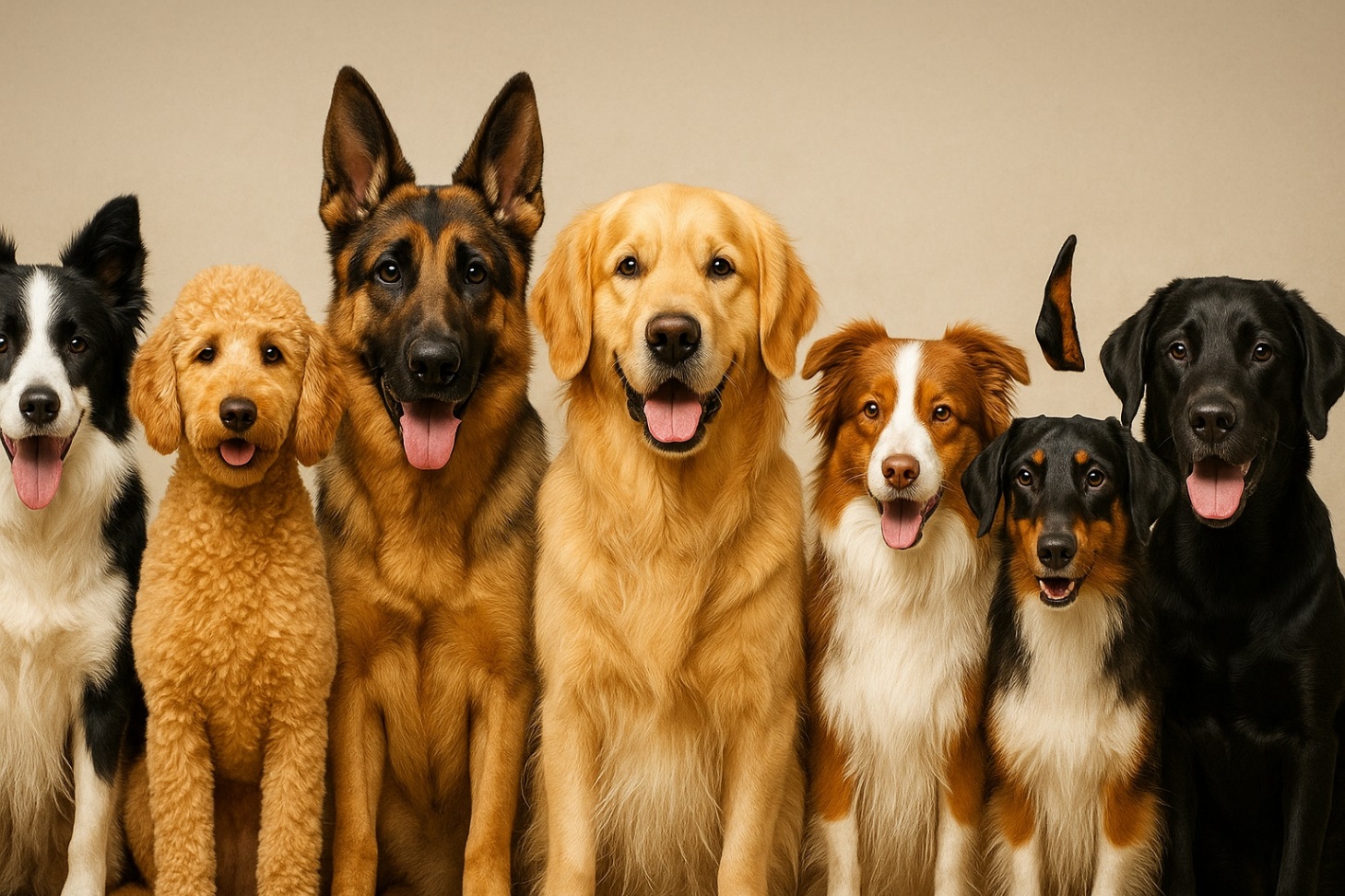In this article, you'll discover ten unexpected facts about the world's smartest dog breeds, backed by science and expert research.
While all dogs are capable of basic training, some breeds stand out for their mental agility and quick command retention.
Recent studies have revealed surprising insights into how dogs think, process language, and solve tasks.

1. Border Collies Can Learn Over 1,000 Words
Border Collies aren't just fast—they're linguists!
In lab tests, one famously named “Chaser” learned more than 1,000 toys by name and even understood grammar-style exclusion tasks.
Another Collie, “Betsy,” impressively demonstrated a real-world ‘photo-to-object’ mapping and learned 340 words in as few as two exposures.
This level of word recognition rivals that of a 2-year-old child. It challenges the belief that only primates or humans can grasp symbolic language on such a scale.
2. Quick Learners: Border Collies Pick Up Commands in Under Five Repetitions
Psychologist Stanley Coren found that Border Collies can learn a new command in fewer than five repetitions.
They respond correctly the first time 95% of the time. This puts them at the very top of obedience intelligence rankings.
It shows how fast canine learning can be, with fewer repetitions than many humans need. It redefines what “obedience” training can look like.
3. Smart Doesn’t Mean Small: Shetland Sheepdogs Punch Above Their Weight
Often called “mini-border collies,” Shetland Sheepdogs also ranked high in Coren’s study.
They, too, learn commands in under five tries and obey at the same 95% rate.
These compact herders excel in agility and obedience competitions wisdompanel.com.
Despite being small, they match large working breeds in mental capacity. This flips the common assumption that small dogs are less capable or harder to train.
4. Dobermans Lead in Trainability, Despite Their Guard-Dog Aura
Contrary to their tough image, Doberman Pinschers are among the most trainable.
In Coren’s surveys, they ranked fifth in obedience, and independent studies even placed them first for general trainability.
Their intimidating look contrasts with their actual mental flexibility and eagerness to learn, breaking the stereotype that protection breeds.
5. Poodles—Brains Behind the Fur
Poodles often get overlooked, but they rank just behind Border Collies in intelligence. Coren’s rankings place them second for working intelligence rd.com.
Their intellectual versatility extends to performing arts, obedience, and even therapy roles.
People often dismiss Poodles due to their appearance, but they’re second only to Border Collies in many intelligence tests.
6. Golden and Labrador Retrievers: Emotional Intelligence Stars
Not only do Golden Retrievers and Labs demonstrate strong obedience, but their emotional intelligence shines in therapy and service work.
Goldens are naturally empathetic; Labs are patient learners with excellent recall skills.
It shows that intelligence isn’t only about commands—it includes empathy and situational awareness.
7. Small Breeds, Big Brains: Papillons and Miniature Schnauzers
Compact breeds like Papillons and Miniature Schnauzers rank in the top 15 smartest breeds.
Papillons excel in agility and memory, while Miniature Schnauzers earn top marks for problem-solving and trainability.
They’re agile, quick-thinking, and excel in tasks typically dominated by bigger breeds. This reminds us that cognitive ability isn’t determined by size.
8. Working-Dog Roots: Intelligence from Purpose
Most top dog breeds began as working dogs—Border Collies herded sheep, Dobermans guarded tax collectors, and Shepherds guided military operations.
Generations of selective breeding sharpened their instincts and cognitive skills.
These breeds weren’t bred to be cute—they were bred to think, solve problems, and act independently. Their intelligence is deeply practical.
9. Smarter Dogs Can Have Smaller Brains
Common assumptions link size and smarts, big brain = intelligent.
Newer research shows pups with relatively smaller brain volumes are often more trainable and perform better on cognitive tasks thetimes.co.uk.
Highly trainable working breeds like Rottweilers and Dobermans top the charts.
Whereas, some toy breeds, despite their brain size, show less social or obedience capability.
10. Dogs Process Human Language Like Young Children
A 2024 study using EEG scans found that dogs show distinct brain responses when hearing familiar object names versus random words.
This indicates they’re not just reacting to tone—they're mentally linking words to objects, much like a toddler would thetimes.co.uk.
This places dogs cognitively closer to humans than previously thought.
It supports the idea that they don’t just react to tone—they understand meaning and associate words with real-world objects.
Why Breed Intelligence Matters
Smart breeds generally rank high in both obedience and adaptive intelligence, making them ideal for tasks like search-and-rescue, therapy, and obedience sports.
- Purpose-built brains: Herding, guarding, and retrieving require complex social interaction and autonomous decision-making.
- Obedience vs. adaptive intelligence: Coren categorized intelligence into three types:
- Instinctive: innate talents like herding or retrieving
- Obedience/training: How quickly dogs follow commands
- Adaptive problem-solving: dogs learning in new situations en.wikipedia.org
Implications for Smartest Dog Breeds’ Owners
Whether you're training a working dog, teaching tricks to a pint-sized Papillon, or just curious about canine cognition.
The smartest dog breeds are truly fascinating and demanding.
- Mental stimulation is essential. Smart breeds can become bored easily—create puzzle toys, agility courses, training routines, and interactive games.
- Consistency and patience pay off. Teaching a Poodle or Collie a trick? Expect a few sessions for command mastery, but results will be swift.
- Don’t underestimate small breeds. Tiny breeds like Papillons and Schnauzers are intellectually robust studio stars and athletes.
- Individual variation counts. A working lineage or show lineage can influence intelligence and temperament, even within the same breed.

Breed Snapshots
Smartest Dog Breeds:
| Breed | Intelligence Highlights | Intelligence Ranking |
|---|---|---|
| Border Collie |
|
#1 |
| Poodle | 2nd in working intelligence | Top 3 |
| German Shepherd | Police/service star, extreme trainability | Top 5 |
| Doberman Pinscher | Ranked #5 in obedience, #1 trainability in studies | |
| Golden Retriever | Emotional intelligence, therapy excellence | Top 10 |
| Labrador Retriever | Service dog staple, easy learner | Top 10 |
| Shetland Sheepdog | Mini-collie agility star | #6 |
| Papillon | Small breed agility/memory whiz | Top 15 |
| Miniature Schnauzer | Problem-solver, top 15 breed | |
| Rottweiler | High trainability despite size |
Final Thoughts
Smartest dog breeds have far more intelligence than they're often given credit for.
From vocabulary skills rivaling toddlers to the unexpected correlation between brain-to-body ratios and obedience, these facts challenge our assumptions.
By understanding their intelligence, you can better meet their needs—mentally, physically, and emotionally.




















